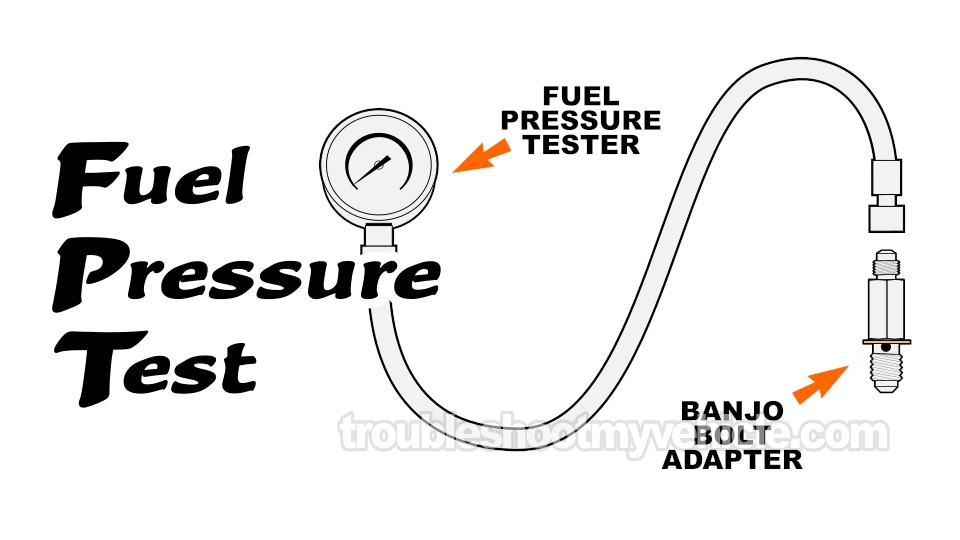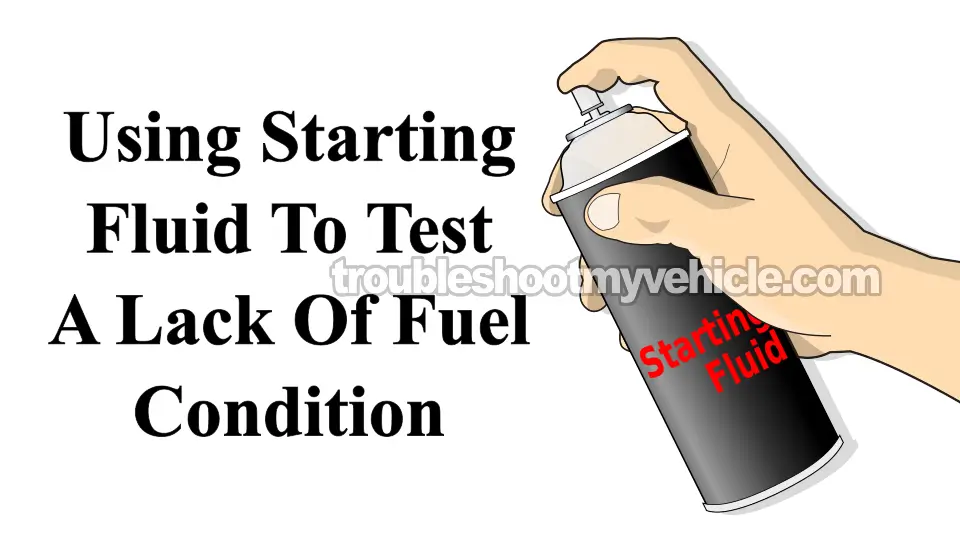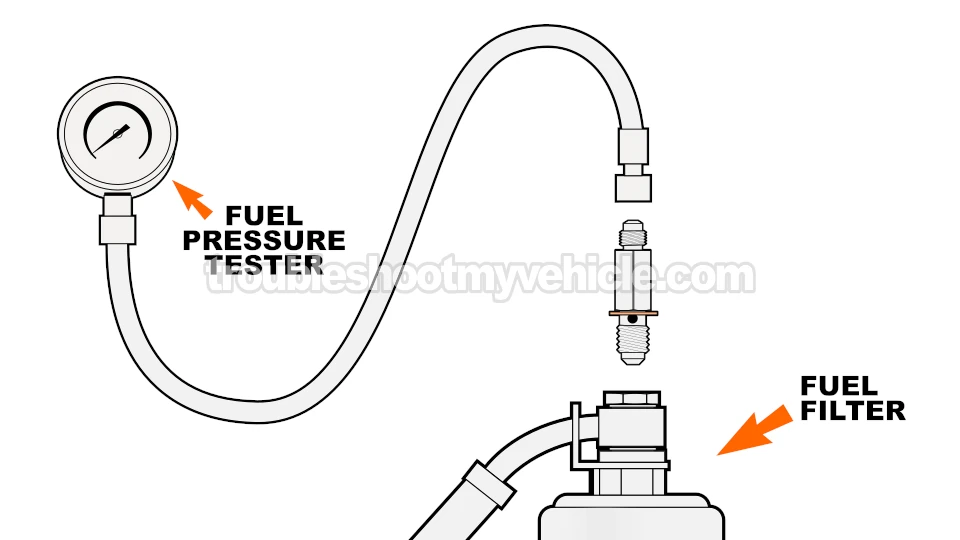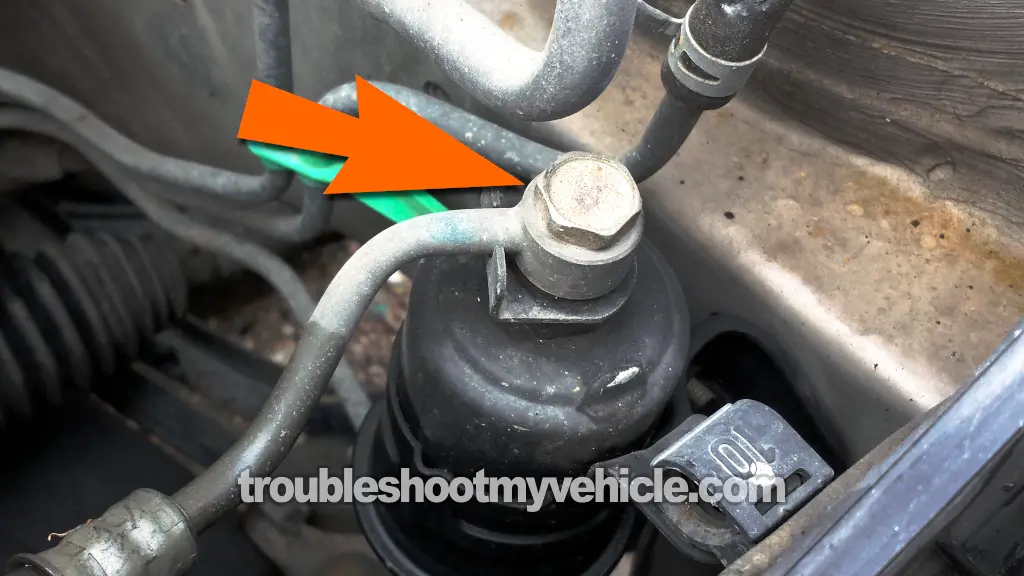
Testing your 1997 1.6L Toyota Corolla's fuel pump with a fuel pressure test gauge is pretty simple.
If your Corolla won't start or runs poorly, and you think the fuel pump's the problem, a fuel pressure test is gonna help you figure it out.
In this step-by-step tutorial, I'll show you how to hook up the gauge, what pressure readings it should read, and a quick starting fluid trick to check if a lack of fuel issue is behind the engine no-start.
Contents of this tutorial:
- Symptoms Of A Bad Fuel Pump.
- Where To Buy A Fuel Pressure Test Gauge.
- TEST 1: Checking Fuel Pressure With A Fuel Pressure Gauge (With Scan Tool).
- TEST 2: Checking Fuel Pressure With A Fuel Pressure Gauge (Without Scan Tool).
- TEST 3: Using Starting Fluid To Confirm Lack Of Fuel.
- More 1.6L Toyota Corolla Tutorials.
APPLIES TO: This tutorial applies to the following vehicles:
- 1.6L Toyota Corolla: 1997.
- 1.6L Geo Prizm: 1997.
Engine No-Start Diagnostics:
Toyota Fuel Pump Test Tutorials:
- How To Test The Fuel Pump (1989-1992 1.6L Toyota Corolla).
- How To Test The Fuel Pump (1993-1996 1.6L Toyota Corolla).
Wiring Diagrams:
Symptoms Of A Bad Fuel Pump
Your Corolla's fuel pump is gonna fail at some point, causing one of two problems:
- It completely stops working: When that happens, you can't start the engine because no fuel's getting to it.
- It starts failing slowly: In this case, your Corolla still starts, but you'll notice engine performance issues, especially when accelerating from a stop or driving uphill.
When your 1.6L Toyota Corolla's fuel pump completely fails, you'll notice these signs:
- Engine won't start: You turn the key, the engine cranks, but it doesn't fire up.
- Ignition system's fine: A spark test shows all cylinders are getting spark, so the ignition system isn't the problem.
- Fuel injectors are working: A Noid light test confirms the fuel injection computer's pulsing the injectors.
- No fuel pressure: The fuel pressure test gauge reads zero, which means the fuel pump's done for.
- Starting fluid gets the engine to start and run a few seconds: If you spray some into the throttle body and try again, the engine runs for a few seconds before dying.
If your fuel pump's starting to fail but still sending just enough fuel to keep the engine running, you'll probably notice one or more of these signs:
- Check engine light with trouble codes: Your Corolla's fuel injection computer throws lean air/fuel mixture codes.
- Rough idle: The engine runs unevenly at idle.
- Hard to start: You gotta crank the engine longer than usual to get it going.
- Lack of power: When you step on the gas, the engine feels weak and struggles to move the car.
- Backfiring in the intake: You hear popping sounds from the intake manifold when pushing the engine hard.
Testing the fuel pressure is a must if you wanna know whether the fuel pump's behind the no-start or performance issues. It'll also keep you from wasting money on parts that won't fix the problem.
Where To Buy A Fuel Pressure Test Gauge
If you wanna diagnose a bad fuel pump like a DIY pro, you're gonna need a fuel pressure gauge. You can grab one at most auto parts stores or order it online.
For your 1.6L Toyota Corolla, these budget-friendly fuel pressure test gauge kits come with adapters to make testing the fuel pump pressure easier:
Disclosure: As an Amazon Associate, I earn from qualifying purchases. If my tutorials help you, using these links is an easy way to support the site at no extra cost to you. Thank you!
NOTE: All of the fuel pump pressure test kits above have the fitting that will connect to your Toyota's fuel system.
TEST 1: Checking Fuel Pressure With A Fuel Pressure Gauge (With Scan Tool)
If you've got a scan tool with "active test" capability that lets you turn on the fuel pump with the key on and engine off, keep reading. If not, skip ahead to TEST 3.
We're gonna connect a fuel pressure test gauge to the output side of the fuel filter using a special adapter.
Then, we'll use the scan tool to activate the fuel pump and compare the pressure reading to the spec.
| Key On Engine Off (fuel pump activated by scan tool). |
|---|
| 38-44 PSI |
NOTE: If you don't have a fuel pressure gauge, take a look at the section: Where To Buy A Fuel Pressure Test Gauge.
OK, let's get started:
- 1
Pop off the top part of the air filter assembly and the air duct connected to the throttle body so you can get to the fuel filter.
- 2
Wrap a shop towel around the fuel filter's union bolt (see photo 3 of 4 above).
The towel's there to catch any fuel that might leak, drip, or spray when you loosen the bolt, just in case there's still pressure in the line. - 3
Take out the fuel filter's union bolt.
NOTE: Keep an eye on the two copper washers on the bolt. Don't drop them into the engine bay or Ground —you'll need them when putting everything back together. - 4
Screw in the fuel pressure test kit's adapter where the union bolt was and tighten it up.
- 5
Turn the key ON and OFF several times (but don't crank or start the engine) to activate the fuel pump and check for fuel leaks around the fuel gauge adapter.
NOTE: Check the fuel pressure gauge's adapter connection for fuel leaks. If any leaks are present, turn the key OFF and resolve them to get an accurate fuel pressure output result. - 6
Turn the key to the ON position but don't crank or start the engine.
- 7
Connect the scan tool and go to its "Active Tests" section.
- 8
Activate the fuel pump via the scan tool.
- 9
Your fuel pressure gauge should register: 38-44 PSI.
Here's what your results mean:
CASE 1: The fuel pressure gauge shows 0 PSI. This confirms your 1.6L Toyota Corolla isn't starting because the fuel pump isn't sending fuel to the injectors.
CASE 2: The fuel pressure gauge reads the correct fuel pressure. That means the fuel pump's working and supplying enough fuel to the injectors.
If you're dealing with a no-start or performance issue, something else is causing it. The fuel pump's fine.
CASE 3: The fuel pressure gauge shows lower-than-specified pressure (but not 0 PSI). This tells you the fuel pump's weak and starting to fail.
It's still moving some fuel, but not enough for the engine to start or run right. You'll need to replace the fuel pump.
TEST 2: Checking Fuel Pressure With A Fuel Pressure Gauge (Without Scan Tool)
You don't need a scan tool to test the fuel pump, and in this section, I'll show you how.
To measure the fuel pump's pressure, you'll connect a fuel pressure test gauge to the output side of the fuel filter using a special adapter.
I'll walk you through the whole setup step by step in the instructions below.
| Engine running or engine cranking |
|---|
| 44-50 PSI |
NOTE: If you don't have a fuel pressure gauge, take a look at the section: Where To Buy A Fuel Pressure Test Gauge.
Alright, let's get started:
- 1
Remove the top part of the air filter assembly and the air duct connected to the throttle body so you can reach the fuel filter.
- 2
Wrap a shop towel around the fuel filter's union bolt (see photo 3 of 4 above).
The towel's there to catch any fuel that might leak, drip, or spray when you loosen the bolt, in case there's still pressure in the line. - 3
Remove the fuel filter's union bolt.
NOTE: Watch out for the two copper washers on the bolt. Don't drop them into the engine bay —you'll need them when reassembling. - 4
Install the fuel pressure test kit's adapter where the union bolt was and tighten it securely.
- 5
Turn the key ON and OFF a few times (without starting the engine) to activate the fuel pump and check for leaks around the connections.
NOTE: If you see any leaks, turn the key OFF and fix them before moving on. - 6
Crank and start the engine.
NOTE: If the engine doesn't start, no problem. Just crank it long enough to get a fuel pressure reading on the gauge. - 7
Your fuel pressure gauge should read:
Engine running: 44-50 PSI.
Engine cranking (but not starting): 44-50 PSI.
Here's what your results mean:
CASE 1: The fuel pressure gauge reads 0 PSI. This confirms your 1.6L Toyota Corolla isn't starting because the fuel pump isn't sending fuel to the injectors.
CASE 2: The fuel pressure gauge shows the correct fuel pressure. That means the fuel pump's working and supplying enough fuel to the injectors.
If your Corolla still won't start, something else is causing the problem. The fuel pump's fine.
CASE 3: The fuel pressure gauge shows lower-than-specified pressure (but not 0 PSI). This tells you the fuel pump's weak and starting to fail.
It's still moving some fuel, but not enough for the engine to start or run right. You'll need to replace the fuel pump.
TEST 3: Using Starting Fluid To Confirm Lack Of Fuel

The starting fluid test is a tried-and-true way to diagnose an engine no-start issue caused by a lack of fuel.
Here's how it works: Spray some starting fluid into the throttle body, crank the engine, and see if it fires up.
Basically, if your Corolla's fuel system is the reason the engine won't start, the starting fluid should get it running for a few seconds.
While this isn't the most precise way to confirm a bad fuel pump, it's great for quickly figuring out if a lack of fuel is the issue. I've used this method for years, and it works well.
Before running the test, make sure all four cylinders are getting spark. Use a spark tester for an accurate check.
IMPORTANT: After spraying the starting fluid into the throttle body, put the air intake duct back on. You don't have to tighten the hose clamp —just make sure it's in place. That way, if the engine backfires while cranking, the flames won't shoot out of the throttle body.
Here's what you need to do:
- 1
Pull off the intake air duct from the throttle body. No need to remove it completely since you'll be reconnecting it in a later step.
- 2
Hold the throttle plate open and spray starting fluid into the bore.
For safety, reconnect the air duct after spraying a good amount of starting fluid. You don't have to tighten the hose clamp. - 3
Crank the engine once the air duct is back in place and you're clear of the engine bay.
- 4
One of two things will happen:
1.) The engine starts and runs for a few seconds.
2.) The engine doesn't start.
Alright, let's break down what your results mean:
CASE 1: The engine started and ran for a few seconds. This means the no-start issue is caused by a lack of fuel.
Your next step is to check the fuel pressure using a fuel pressure test gauge. Head over to: TEST 1: Checking Fuel Pressure With A Fuel Pressure Gauge.
CASE 2: The engine didn't start, not even for a moment. This usually means a lack of fuel ISN'T the reason your car won't start.
Remember how I mentioned this test isn't the most accurate? That's why I recommend one more check —testing the fuel pressure with a fuel pressure test gauge. Go to: TEST 1: Checking Fuel Pressure With A Fuel Pressure Gauge.
More 1.6L Toyota Corolla Tutorials
You can find a complete list of 1.6L Toyota Corolla tutorials and wiring diagrams in this index:
Here's a sample of the tutorials you'll find there:
- How To Test A Blown Head Gasket (1989-1997 1.6L Toyota Corolla).
- How To Test Engine Compression (1989-1997 1.6L Toyota Corolla).
- How To Test The Fuel Injectors (1993-1997 1.6L Toyota Corolla).
- How To Test The Throttle Position Sensor (1989-1997 1.6L Toyota Corolla).

If this info saved the day, buy me a beer!







